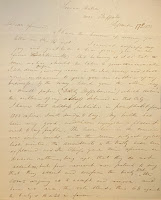“I shall endeavor to return to Hanover as soon as I can leave the place [and] the Council. I am a chief, therefore it is difficult to leave them before it closes…No man regrets so much as I do, of my absence from the College. But I am placed over this people to see that the republic receive no detriment.”
Not only did Pierce fulfill his chiefly duties, but he also spoke out for his beliefs. In his letter to Thayer, Pierce references a speech he had delivered in 1838 at Buffalo, expressing his anti-land-removal stance. This address in particular made its way to the local newspaper, The Daily Buffalonian, and inspired many of his peers. One of his Dartmouth classmates, E.F. Slafter, wrote (“[on] behalf of the Junior class”) a note to Pierce stating his gratitude for Pierce’s inspiring words:
“We would express our hearty thanks for your eloquent and highly valuable address delivered at Buffalo, N.Y. upon the condition etc. of your people Which we shall ever read it with the deepest interest both from its own intrinsic value and the sympathy we feel for your people it will even feel to bring to mind the pleasing associations of College life when we assemble in the same halls of learning and were bound together by a common bond of interest and pursuit.”
After graduating from Dartmouth College in 1840, Pierce pursued law and continued to fight for the Seneca Nation and its land rights. He used his Dartmouth education to become a mediator between the two cultures as he argued against Seneca land removal. In addition, Pierce became an interpreter for the Seneca Nation and the U.S. government, a role perhaps hinted at by his time at Dartmouth. As shown by his transcript for his freshman and sophomore years, Pierce was not only a high-achieving student (with a GPA higher than his classmates), but also had exceptional language skills, receiving an exquisite 4.0 in the language column:
While Pierce graduated in 1840, we can still learn from him today. Pierce’s experience mirrors the struggles of many students today, particularly first-generation students: many times, issues at home can compete with educational commitments—and sometimes a student’s home community needs to take precedence over the student’s individual betterment, as was the case with Pierce. Like students today, Pierce also had to balance responsibilities on both sides of his life. In addition, throughout his career, he brought his Dartmouth education and his inherent passion to the larger community and applied it to every aspect of his work life: his writings, his speeches, his tribal negotiations.
If you’re interested in reading Pierce’s letter to Loren Thayer or a facsimile of E.F. Slafter’s letter to Pierce, come to Special Collections and ask for Mss 838517 and Mss 838540.2 (a transcription is included for both). If you want to see Pierce’s grades as recorded in the College’s Merit Rolls, ask for DA-80, Box 3292 (look for 1837, Freshman Class, and 1838, Sophomore Class). For more about Pierce’s life after Dartmouth, ask for his Alumni File.
“We would express our hearty thanks for your eloquent and highly valuable address delivered at Buffalo, N.Y. upon the condition etc. of your people Which we shall ever read it with the deepest interest both from its own intrinsic value and the sympathy we feel for your people it will even feel to bring to mind the pleasing associations of College life when we assemble in the same halls of learning and were bound together by a common bond of interest and pursuit.”
After graduating from Dartmouth College in 1840, Pierce pursued law and continued to fight for the Seneca Nation and its land rights. He used his Dartmouth education to become a mediator between the two cultures as he argued against Seneca land removal. In addition, Pierce became an interpreter for the Seneca Nation and the U.S. government, a role perhaps hinted at by his time at Dartmouth. As shown by his transcript for his freshman and sophomore years, Pierce was not only a high-achieving student (with a GPA higher than his classmates), but also had exceptional language skills, receiving an exquisite 4.0 in the language column:
While Pierce graduated in 1840, we can still learn from him today. Pierce’s experience mirrors the struggles of many students today, particularly first-generation students: many times, issues at home can compete with educational commitments—and sometimes a student’s home community needs to take precedence over the student’s individual betterment, as was the case with Pierce. Like students today, Pierce also had to balance responsibilities on both sides of his life. In addition, throughout his career, he brought his Dartmouth education and his inherent passion to the larger community and applied it to every aspect of his work life: his writings, his speeches, his tribal negotiations.
Moreover, Pierce shows us that Dartmouth students don’t need to wait for graduation to have an impact on a surrounding community: his inspiring speech against land removal was delivered in Buffalo while he was still a sophomore in college. Pierce continued this tradition of advocacy long after he graduated, bringing what he had learned at Dartmouth to bear on every aspect of his adult life. His example is an inspiring one for Dartmouth students from all backgrounds and walks of life.
If you’re interested in reading Pierce’s letter to Loren Thayer or a facsimile of E.F. Slafter’s letter to Pierce, come to Special Collections and ask for Mss 838517 and Mss 838540.2 (a transcription is included for both). If you want to see Pierce’s grades as recorded in the College’s Merit Rolls, ask for DA-80, Box 3292 (look for 1837, Freshman Class, and 1838, Sophomore Class). For more about Pierce’s life after Dartmouth, ask for his Alumni File.


